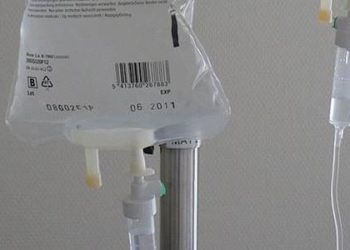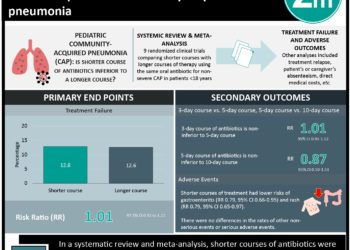High rates of diagnostic discordance in hospitalizations for community-acquired pneumonia
1. In this retrospective cohort study, discordance between initial diagnosis and discharge diagnosis occurred in over half of hospitalizations for community-acquired pneumonia from the emergency department.
2. Documentation of diagnostic uncertainty was found in nearly half of clinical discharge notes, reflecting the persistent challenge of refining diagnoses for nonspecific presentations.
Evidence Rating Level: 2 (Good)
Study Rundown: Community-acquired pneumonia (CAP) is an infection of the lung parenchyma acquired outside of the hospital setting which often leads to symptoms of cough, dyspnea, and increased sputum production. With substantial harms associated with both undertreatment and overtreatment, there is increasing emphasis on the role of accurate diagnosis in the appropriate management of suspected CAP. However, quality improvement can be difficult to achieve especially in fragmented care settings where clinicians who make the initial diagnosis rarely follow the patient throughout their admission. This retrospective study utilized a combination of diagnosis codes and natural language processing (NLP) of clinical text to characterize the evolution of pneumonia diagnoses between presentation and discharge as well as describe factors associated with a higher likelihood of discordance. Overall, it was found that diagnostic discordance between the initial emergency department (ED) presentation and discharge occurred in 56.7% of hospitalizations with CAP. Documentation suggestive of diagnostic uncertainty was highly prevalent both in the ED and at discharge. One-tenth of patients were treated with a combination of antibiotics, corticosteroids, and diuretics within 24 hours. These findings suggest that diagnostic and treatment ambiguity are pervasive among patients hospitalized with pneumonia. This study was limited by its retrospective nature and the inherent imprecision of diagnosis codes. Further, elderly male patients with comorbidities were overrepresented in the study population, thus affecting generalizability.
Click to read the study in AIM
Relevant Reading: Development and evaluation of an interoperable natural language processing system for identifying pneumonia across clinical settings of care and institutions
In-Depth [retrospective cohort]: This retrospective cohort study involved all adult patients who were hospitalized from the ED at any VA medical center from January 1, 2015 to January 31, 2022 with either an initial or discharge diagnosis of pneumonia. Radiologic diagnosis of pneumonia was identified by applying NLP to reports of chest imaging (radiograph and computed tomography). Concordant diagnoses of CAP were defined as those who had an initial diagnosis, positive initial chest imaging, and a discharge diagnosis of CAP. Discordant diagnoses were those who did not have an initial diagnosis but had positive initial chest imaging and a discharge diagnosis; had an initial diagnosis but did not have positive chest imaging; or had an initial diagnosis but did not have a discharge diagnosis. Out of 2,383,899 hospitalizations, 317,413 (13.3%) had a diagnosis of CAP either at admission or discharge, with 215,973 (9.1%) receiving an initial diagnosis and 239,067 (10.0%) receiving a discharge diagnosis. A total of 120,822 (38.1%) of patients had completely concordant diagnoses of CAP, whereas diagnostic discordance occurred in 179,834 (56.7%) patients. Among patients with a positive chest radiograph and a discharge diagnosis of CAP, 33.4% of individuals lacked an initial diagnosis or treatment. Conversely, after an initial diagnosis of CAP, 21.0% of patients lacked positive initial chest imaging and 36.3% lacked a discharge diagnosis. It was found that 58% of ED notes and 49% of discharge notes had assertions of diagnostic uncertainty. In terms of initial treatment, 36% of patients received corticosteroids, 27% received diuretics, and 10% received antibiotics, corticosteroids, and diuretics within 24 hours. Patients with diagnostic discordance were more likely to have been treated at high-complexity facilities with greater patient volume. In summary, this study demonstrates high rates of diagnostic discordance, uncertainty, and treatment ambiguity in patients with CAP.
Image: PD
©2024 2 Minute Medicine, Inc. All rights reserved. No works may be reproduced without expressed written consent from 2 Minute Medicine, Inc. Inquire about licensing here. No article should be construed as medical advice and is not intended as such by the authors or by 2 Minute Medicine, Inc.








